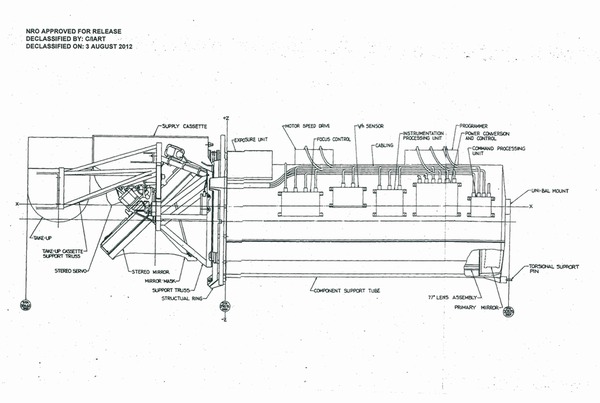Project Upward: hauling the NRO’s GAMBIT to the Moonby Philip Horzempa
|
| The flip side of this was the risk of cooperating with NASA. From the start, there was concern in the intelligence community about security. |
Essentially, Upward was a plan to haul a modified reconnaissance satellite to lunar orbit. It can trace its origins to 1962, when the NRO offered the use of its camera systems to NASA for the purpose of certifying landing sites for Apollo. To quote the NRO history of Upward, “developing a new camera system for NASA would constitute a massive and costly duplication of effort…”1
The flip side of this was the risk of cooperating with NASA. From the start, there was concern in the intelligence community about security. Again to quote the NRO history, “…the existence of the Gambit, Corona, Lanyard and Argon satellite reconnaissance systems was unknown outside the select group that developed and operated them. The possibility that reconnaissance operations of the chosen system could be compromised by its use in conjunction with Apollo could scarcely be ignored.”
One result of the NRO offer was the unmanned Lunar Orbiter project, which used technology developed for the Samos E-1 recon project. The other product of this collaboration was the Upward/LMSS project (initial code name Elba), which was part of the manned Apollo program. This effort called for the inclusion of a high-resolution Survey camera in Bay 1 of the Apollo Service Module (SM). NASA reviewed several NRO camera systems for this effort, with a final competition between the Lanyard’s KH-6 and Gambit’s KH-7. Kodak’s KH-7 won the competition and was signed on in April 1965.
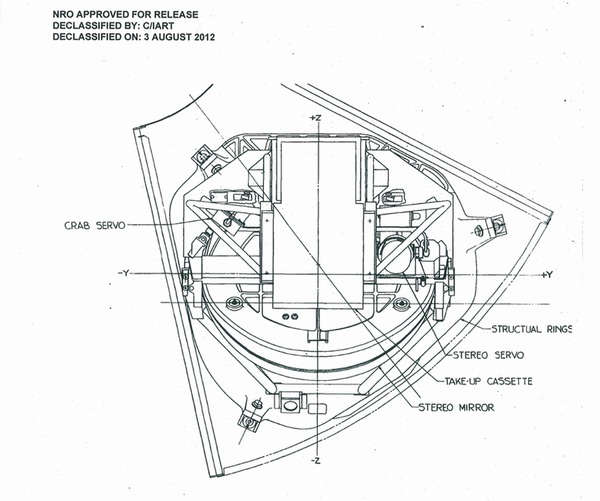 Figure 2a: Kodak schematic of KH-7 camera in Apollo Service Module Bay 1. (credit: NRO) |
The new Upward material includes some detailed diagrams of the KH-7 camera, one of which is shown in Figure 1 above. Figure 2a is a schematic showing how the KH-7 would fit in Bay 1 of the Apollo SM. Figures 2b is an artist’s depiction of this same setup.
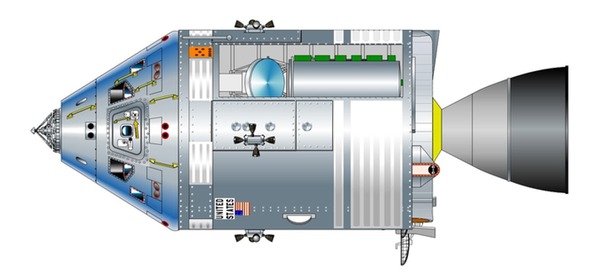 Figure 2b: Artist's depiction of KH-7 in Apollo SM Bay 1. (credit: Giuseppe de Chiara) |
NASA hoped that an early Apollo-LMSS mission, spending at least four days in lunar orbit, would be able to survey ten candidate landing sites on the Moon.
In early 1966, the Upward project underwent a profound change. NASA discussed with the NRO its desire to relocate the KH-7 in a standard Gambit satellite Orbital Control Vehicle (OCV). This resulted in a competition between payload modules built by General Electric and Lockheed. The former company provided the Gambit-1 OCV, while the latter manufactured the Gambit-3’s OCV (with first launch in July 1966.) Lockheed was selected in June 1966. The new plan would place the KH-7 (designed for the Gambit-1 series) in Lockheed’s Gambit-3 OCV. Five flight units, at a total cost of $48.5 million, would be delivered to NASA. The dimensions of the LMSS were 5.5 by 1.5 meters (18 by 5 feet), with a baseline mass of 2,085 kilograms (4,600 pounds). The flight programmer, attitude control, and power supply would be eliminated. However, a shell was still required to contain the camera, along with a thermal control system and an interface with the Apollo Command Module (CM) to provide power and command.
Figure 3 shows a Gambit-3 OCV located in the museum at Wright-Patterson Air Force Base in Dayton, Ohio.
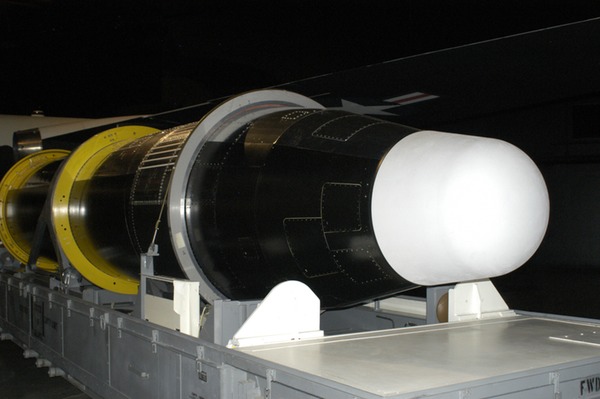 Figure 3: Photo of Gambit-3 OCV at Wright-Patterson AFB. (credit: National Museum of the USAF, Wright-Patterson AFB, Dayton, Ohio) |
An artist’s conception is shown in Figure 4, depicting the LMSS/Upward module in lunar orbit. Figures 5 and 6 are artist depictions showing the Gambit-3 LMSS/Upward module docked with the Apollo.
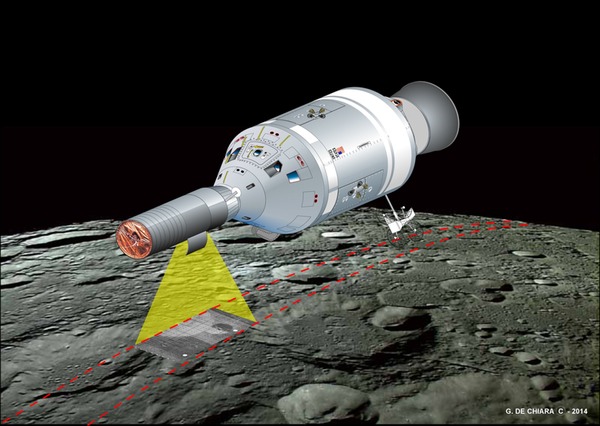 Figure 4: Artist’s depiction of Apollo-LMSS in lunar orbit. (credit: Giuseppe de Chiara) |
In December 1966, another NASA decision caused a change in direction in the Upward program. The agency determined that it had enough high-resolution images from the first two Lunar Orbiters to make a landing site decision for Apollo. Suddenly, the original reason for Upward, lunar site certification, had disappeared. It now had a new goal: Earth observations. By early 1967, NASA wanted to include the LMSS module in the Apollo Applications Program (AAP). It would be included in a four-flight effort to assemble an Earth orbital cluster. Within a few months, the LMSS/Upward mission was restructured to be a solo AAP mission in Earth orbit. These plans provoked a storm of protest from the intelligence community.
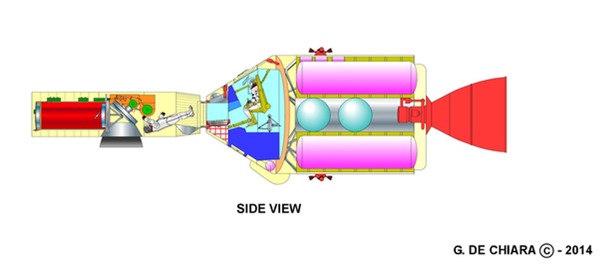 Figure 5: Artist’s depiction of Gambit-3 LMSS; internal (credit: Giuseppe de Chiara) |
In early 1967, a number of officials expressed their concern that the use of the LMSS in Earth orbit would compromise the security of America’s reconnaissance program. These officials, including Deputy Secretary of Defense Cyrus Vance, objected to NASA’s use of a “Gambit-by-any-other-name” for Earth observations. There had been a secret agreement in August 1963 between NASA and the intelligence agencies that limited the resolution of any NASA images of the Earth to 18 meters (60 feet.) Now, NASA was ready to obtain imagery with a resolution of 0.6–1.2 meters (2–4 feet)! There were fears that the use of the civilian Gambit in a public program, such as AAP, would make it impossible to keep the high-resolution photos secret. The existence of the Gambit program itself might be exposed. NRO Director Alexander Flax worried that NASA’s use of these classified cameras would be, “…conducted in the whitest of white lights of publicity.”1 An interagency policy review board concluded that NASA’s plans for the use of the KH-7 deviated significantly from the guidelines of the August 1963 agreement.
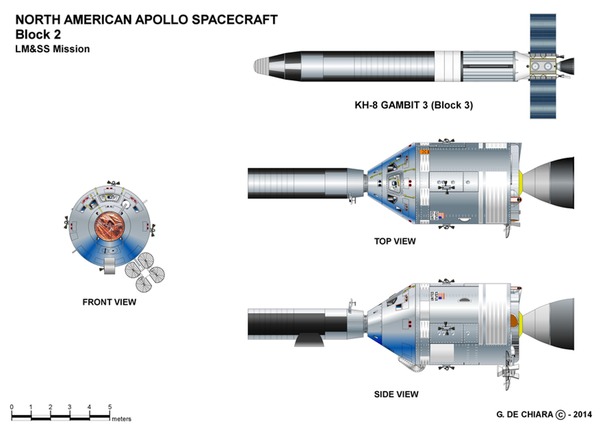 Figure 6: Artist’s depiction of Gambit-3 LMSS; externa; (credit: Giuseppe de Chiara) |
At this time, General Electric approached NASA with an offer to sell Gambit-1 OCV modules to the agency. This was the Percheron concept, and it seemed to offer a simpler way for NASA to conduct Earth surveys. After several months, the offer fell apart as GE did not have all of the resources (launch pads, recovery teams, etc.) necessary for a viable program. Upward was still NASA’s only horse in the stable. However, if NASA had been able to pursue the Percheron option, it is hard to see how this would have been any more acceptable to the intelligence community.
| The LMSS was tantalizingly close to flight capability when it was canceled. |
There were efforts to “rescue” the project by several parties. These were reviewed in my article for Quest (Vol. 20, #1), “More Details on NASA’s Lunar Reconnaissance Program.” The LMSS design could be used for several options. A crash during an early Apollo landing mission could be investigated by an emergency LMSS mission. Upward could be flown as close as eight kilometers (five miles) above the Moon in such a forensic mission. It is possible that the resolution at that altitude could be as sharp as 15 centimeters (6 inches).
The LMSS payload module could be used for lunar remote sensing. It could also scout for landing sites for Advanced Apollo missions. A global survey of the Moon from polar orbit was possible.
These arguments did not carry the day and on July 25, 1967, Upward was canceled. The LMSS was tantalizingly close to flight capability when it was canceled. At that time, two of the planned five flight units were close to completion. In fact, the first unit was to begin vibration/acoustic testing at the Manned Spaceflight Center in Houston on September 15, 1967. It is not known what became of those modules after cancellation. However, NASA requested, and was granted, permission to use Upward’s Itek mapping cameras in the agency’s Earth Resources Survey System. It is unclear what program may have used them.
There are several subplots in the Upward story. The LMSS module would probably have been left behind in lunar orbit after the Apollo crew retrieved its film load. This may have inspired NASA to consider the capability of independent flight. A simple version would have allowed Upward to hibernate in lunar orbit between missions. This was to have been tested in the Earth orbit AAP mission.
A more complex approach would have included an LMSS capable of continuing a lunar mapping mission after the Apollo crew had reloaded its film. In its engineering proposal, Kodak had described how the LMSS could be equipped with the Bimat system that it had developed for Lunar Orbiter. Such an onboard processing and readout capacity would have allowed the astronauts to gauge the status of the KH-7 camera. After the crew had departed, this would have enabled Upward to continue an unmanned survey mission. Some years later, a similar system was considered by the NRO for real-time Earth reconnaissance. This Film Read Out Gambit (FROG) was cancelled when the NRO decided to pursue electronic read-out in its KH-11 satellite.
Another subplot deals with the mapping camera that was part of the original Service Module design. Fairchild won the contract to build that imager in 1965. When Upward was restructured in 1966, the Fairchild camera was canceled. The new LMSS design would instead use the standard Gambit Itek context camera. The Fairchild camera, however, had an interesting career. It was used in the Corona program in 1967–1969 and was known as the DISIC (Dual-Integrated-Stellar-Index Camera). This was a very capable camera, superior in resolution to that of the NRO’s Argon KH-5 system. It was also considered as a payload for one of the augmented Lunar Orbiter series that were to have flown in the 1970’s. Those heavyweight spacecraft—1,000 kilograms (2,200 pounds)—had the ability to return 14 kilograms (30 pounds) of film to the Earth.
| The story of Upward is now clearer. However, there are still many open items. If NASA had conducted an Apollo-Upward mission to the Moon, the security implications of flying a Gambit are open to speculation. |
Even though officially canceled, the Upward program was de facto reborn (without the Upward or LMSS names) for the Apollo J-series of missions. The Science Instrument Module (SIM) Bay payload was essentially a return to the original Upward approach of 1963–1966. There must have been cooperation with the intelligence community as Apollo 15, 16, and 17 included reconnaissance cameras. The mapping, or metric, camera flown in those missions was none other than the original Upward Fairchild DISIC camera. The Panoramic Camera used for the SIM Bay missions was the Itek KA-80A developed for a recon aircraft.
One of the mysteries of the Upward program was the fate of equipment that had been built for it. The LMSS module would have been carried atop the S-IVB Saturn upper stage. To support it during launch, a truss, or rack, was needed. Components of this rack were in the pipeline when Upward was cancelled in 1967. It is unknown what happened to that structure. Perhaps it was used as an S-IVB support structure for the Apollo-Soyuz Docking Module (DM). Figure 7 shows the launch configuration for Apollo-Soyuz. A similar setup would have been used for Upward.
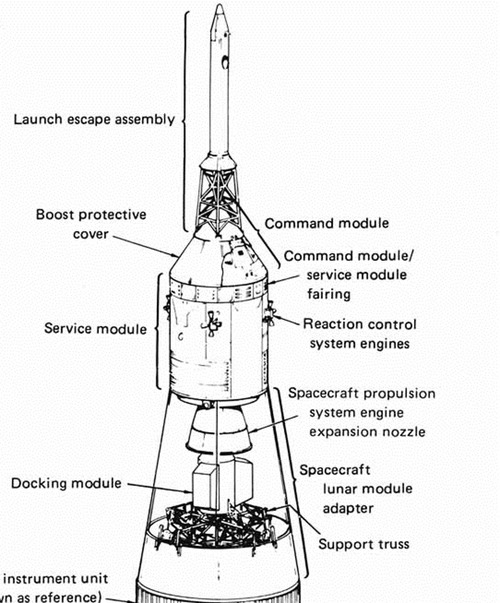 Figure 7: Launch configuration of Apollo-Soyuz DM and S-IVB Truss. (credit: NASA) |
In addition, docking equipment had already been prepared for the Upward module. Was this also used for the DM? Figure 8 shows a photo of a pre-flight docking test for Apollo-Soyuz, which gives an idea of how the LMSS-Apollo combination may have appeared.
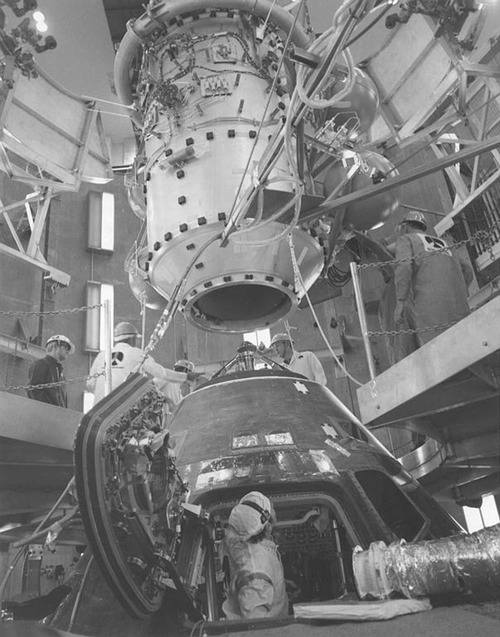 Figure 8: Pre-launch docking test of Apollo and Docking Module. (credit: NASA) |
An interesting sideline to this story was the squabble over who would build the Upward rack. The competition was between Lockheed and NASA’s Marshall Space Flight Center in Huntsville. The NRO believed that the fastest and cheapest course of action was for Lockheed to build the structure. This seemed logical as Upward would be using equipment from a highly classified program and Lockheed’s personnel already had “Top Secret” clearances. If NASA insisted that Marshall personnel be used, then additional time and money would be needed to “clear” that new group. In the end, the work went to Marshall.
There may have been a bit more to this story. In a parallel sequence of events, the Apollo Telescope Mount (ATM) project also underwent an overhaul in early 1966. Like Upward, its solar telescope payload was no longer to be housed in Bay 1 of the Apollo Service Module, but was to be moved to a separate module, a modified Lunar Module. In July 1966, Marshall also won the contract to build the ATM. One more interesting tidbit is NASA’s study of a precursor Apollo flight in which an unmanned LM would conduct a descent-only landing test on the Moon.
The story of Upward is now clearer. However, there are still many open items. There are no photos of the Upward flight modules. There are no engineering drawings or even sketches of the final Upward Gambit-3 module design. Perhaps the NRO’s decision to declassify may encourage NASA to release any Upward documents that it possesses. This attempt to fly a manned lunar mapper had cost a total of $80 million with an investment of 25 man-years at the NRO.
If NASA had conducted an Apollo-Upward mission to the Moon, the security implications of flying a Gambit are open to speculation. The appearance of the Gambit-3 spacecraft was not revealed until 2011. Would NASA have published any photos of the Upward module taken during a mission to the Moon? Several projects were considered as adjuncts to Apollo, such MOLAB and Lunar Shelter. However, only Upward reached the stage of hardware construction. If NASA had finished construction of Upward Flight Unit #1, would NASA have sent it to the Moon with Apollo 8?
“Rational people working together can accomplish anything they cooperatively attempt.”1 So declared Upward project manager John Hansen. Sadly, in the end, the Upward team was denied an opportunity to demonstrate the powerful capabilities of their machine.
An extended history of Upward will be appearing soon in Quest, the space history quarterly, with the title, “Gambit to the Moon” (with the kind permission of R. Cargill Hall).
Acknowledgments: The diagrams used in this article were created by Giuseppe Chiara. Grazie Mille! Thanks also to Dwayne Day for his help.
References
1 Chapter XVIII of the NRO History “Project Upward, the NRO and NASA”; author unknown; circa 1976. (The official NRO history of the program progressed only to the draft stage.)
